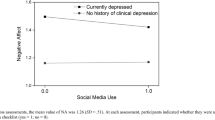Abstract
Studies examining the associations between adolescent social media use and depression/anxiety symptoms show inconsistent results and do not elucidate the direction of associations. Differences in how studies operationalize social media use and consider potential moderating effects of sex and extraversion could contribute to inconsistencies. A distinction has been made between three types of social media use: passive, active and problematic. This study examined longitudinal associations between these types of adolescents’ social media use and depression/anxiety symptoms and moderation effects of sex or extraversion. At ages 13 (T1) and 14 (T2), 257 adolescents completed an online questionnaire regarding their depression and anxiety symptoms and problematic social media use as well as three social media use diaries. Cross-lagged panel modeling (CLPM) revealed a positive association between problematic use and later anxiety symptoms (β = .16, p = .010). Extraversion moderated the association between active use and anxiety (β = -.14, p = .032). Specifically, active use predicted higher subsequent anxiety symptoms only in adolescents with low to moderate levels of extraversion. No sex moderation was found. While social media use (active or problematic) predicted later anxiety symptoms (but not depression), the reverse was not the case. However, highly extraverted individuals seem to be less vulnerable to potential negative effects of social media use.
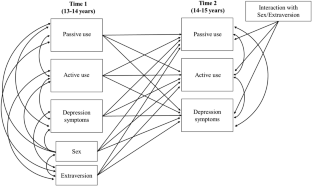
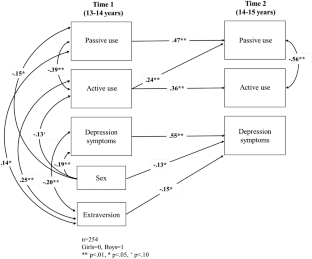

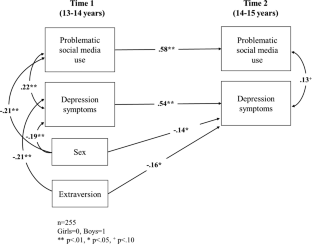
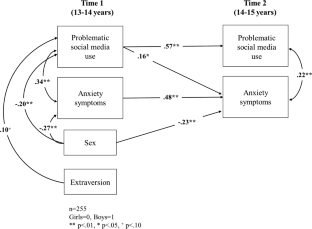
Similar content being viewed by others
References
Abi-Jaoude, E., Naylor, K. T., & Pignatiello, A. (2020). Smartphones, social media use and youth mental health. Canadian Medical Association Journal, 192(6), E136–E141. https://doi.org/10.1503/cmaj.190434.
Ahlen, J., & Ghaderi, A. (2017). Evaluation of the children’s Depression Inventory—Short Version (CDI–S). Psychological Assessment, 29(9), 1157–1166. https://doi.org/10.1037/pas0000419.
Anderson, E. L., Steen, E., & Stavropoulos, V. (2017). Internet use and problematic internet use: A systematic review of longitudinal research trends in adolescence and emergent adulthood. International Journal of adolescence and youth, 22(4), 430–454. https://doi.org/10.1080/02673843.2016.1227716.
Andreassen, C. S., Torsheim, T., Brunborg, G. S., & Pallesen, S. (2012). Development of a Facebook addiction scale. Psychological Reports, 110(2), 501–517. https://doi.org/10.2466/02.09.18.PR0.110.2.501-517.
Andreassen, C. S., Billieux, J., Griffiths, M. D., Kuss, D. J., Demetrovics, Z., Mazzoni, E., & Pallesen, S. (2016). The relationship between addictive use of social media and video games and symptoms of psychiatric disorders: A large-scale cross-sectional study. Psychology of Addictive Behaviors, 30(2), 252–262. https://doi.org/10.1037/adb0000160.
Beyens, I., Pouwels, J. L., van Driel, I. I., Keijsers, L., & Valkenburg, P. M. (2020). The effect of social media on well-being differs from adolescent to adolescent. Scientific Reports, 10(1), 1–11. https://doi.org/10.1038/s41598-020-67727-7.
Boer, M., Stevens, G. W., Finkenauer, C., de Looze, M. E., & van den Eijnden, R. J. (2021). Social media use intensity, social media use problems, and mental health among adolescents: Investigating directionality and mediating processes. Computers in Human Behavior, 116, 106645. https://doi.org/10.1016/j.chb.2020.106645.
Bowden-Green, T., Hinds, J., & Joinson, A. (2020). How is extraversion related to social media use? A literature review. Personality and Individual Differences, 164, 110040. https://doi.org/10.1016/j.paid.2020.110040.
Charrois, J., Côté, S.M., Japel, C., Séguin, J.R., Paquin, S., Tremblay, R.E., & Herba, C.M. (2017). Child‐care quality moderates the association between maternal depression and children’s behavioural outcome. Journal of child psychology and psychiatry, 58(11), 1210–1218. https://doi.org/10.1111/jcpp.12764.
Cheng, C., Wang, H. Y., Sigerson, L., & Chau, C. L. (2019). Do the socially rich get richer? A Nuanced Perspective on Social Network Site Use and Online Social Capital Accrual. Psychological Bulletin, 145(7), 734–764. https://doi.org/10.1037/bul0000198.
Chou, H. T. G., & Edge, N. (2012). They are happier and having better lives than I am”: The impact of using Facebook on perceptions of others’ lives. Cyberpsychology Behavior and Social Networking, 15(2), 117–121. https://doi.org/10.1089/cyber.2011.0324.
Claes, M. (2003). 6. Les relations d’amitié : réciprocité et mutualité. In L’univers social des adolescents Presses de l’Université de Montréal. doi:https://doi.org/10.4000/books.pum.13741
Cohen, J. (1988). Statistical power analysis for the behavioral sciences (2nd ed.). Hillsdale, N.J: L. Erlbaum Associates.
Côté, S. M., Mongeau, C., Japel, C., Xu, Q., Séguin, J. R., & Tremblay, R. E. (2013). Child care quality and cognitive development: Trajectories leading to better preacademic skills. Child Development, 84(2), 752–766. https://doi.org/10.1111/cdev.12007.
Escobar-Viera, C. G., Shensa, A., Bowman, N. D., Sidani, J. E., Knight, J., James, A. E., & Primack, B. A. (2018). Passive and active social media use and depressive symptoms among United States adults. Cyberpsychology Behavior and Social Networking, 21(7), 437–443. https://doi.org/10.1089/cyber.2017.0668.
Feinstein, B. A., Hershenberg, R., Bhatia, V., Latack, J. A., Meuwly, N., & Davila, J. (2013). Negative social comparison on Facebook and depressive symptoms: Rumination as a mechanism. Psychology of Popular Media Culture, 2(3), 161. https://doi.org/10.1037/a0033111.
Frost, R. L., & Rickwood, D. J. (2017). A systematic review of the mental health outcomes associated with Facebook use. Computers in Human Behavior, 76, 576–600. https://doi.org/10.1016/j.chb.2017.08.001.
Geoffroy, M. C., Boivin, M., Arseneault, L., Turecki, G., Vitaro, F., Brendgen, M., & Côté, S. M. (2016). Associations between peer victimization and suicidal ideation and suicide attempt during adolescence: Results from a prospective population-based birth cohort. Journal of the American Academy of Child & Adolescent Psychiatry, 55(2), 99–105. https://doi.org/10.1016/j.jaac.2015.11.010.
Hamaker, E. L., Kuiper, R. M., & Grasman, R. P. (2015). A critique of the cross-lagged panel model. Psychological methods, 20(1), 102–116. https://doi.org/10.1037/a0038889.
Heffer, T., Good, M., Daly, O., MacDonell, E., & Willoughby, T. (2019). The longitudinal association between social-media use and depressive symptoms among adolescents and young adults: An empirical reply to Twenge et al.(2018). Clinical Psychological Science, 7(3), 462–470. https://doi.org/10.1177/21677026188127.
Ivie, E. J., Pettitt, A., Moses, L. J., & Allen, N. B. (2020). A meta-analysis of the association between adolescent social media use and depressive symptoms. Journal of affective disorders, 275, 165–174. https://doi.org/10.1016/j.jad.2020.06.014.
Joseph, J. J., Desjarlais, M., & Herceg, L. (2019). Facebook Depression or Facebook Contentment: The Relation Between Facebook Use and Well-Being. In R. Gopalan (Ed.), Intimacy and Developing Personal Relationships in the Virtual World (pp. 104–125). IGI Global. https://doi.org/10.4018/978-1-5225-4047-2.ch007
Keles, B., McCrae, N., & Grealish, A. (2020). A systematic review: The influence of social media on depression, anxiety and psychological distress in adolescents. International Journal of Adolescence and Youth, 25(1), 79–93. https://doi.org/10.1080/02673843.2019.1590851.
Kessler, R. C., Berglund, P., Demler, O., Jin, R., Merikangas, K. R., & Walters, E. E. (2005). Lifetime prevalence and age-of-onset distributions of DSM-IV disorders in the National Comorbidity Survey Replication. Archives of general psychiatry, 62(6), 593–602. https://doi.org/10.1001/archpsyc.62.6.593.
Kovacs, M. (2003). Children’s Depression Inventory (CDI). Technical manual update. North Tonawanda, NY: Multi-Health Systems.
Kross, E., Verduyn, P., Sheppes, G., Costello, C. K., Jonides, J., & Ybarra, O. (2021). Social media and well-being: Pitfalls, progress, and next steps. Trends in Cognitive Sciences, 25(1), 55–66. https://doi.org/10.1016/j.tics.2020.10.005.
Lemelin, J. P., Provost, M. A., Tarabulsy, G. M., Plamondon, A., & Dufresne, C. (Eds.). (2012). DÉVELOPPEMENT SOCIAL ET ÉMOTIONEL CHEZ L’ENFANT ET L’ADOLESCENT Les bases du développement (tome 1). Presses de l’Université du Québec.
Leys, C., Ley, C., Klein, O., Bernard, P., & Licata, L. (2013). Detecting outliers: Do not use standard deviation around the mean, use absolute deviation around the median. Journal of Experimental Social Psychology, 49(4), 764–766. https://doi.org/10.1016/j.jesp.2013.03.013.
Li, J. B., Mo, P. K., Lau, J. T., Su, X. F., Zhang, X., Wu, A. M., Mai, J. C., & Chen, Y. X. (2018). Online social networking addiction and depression: The results from a large-scale prospective cohort study in chinese adolescents. Journal of behavioral addictions, 7(3), 686–696. https://doi.org/10.1556/2006.7.2018.69.
Little, R. J. (1988). A Test of Missing Completely at Random for Multivariate Data with Missing Values. Journal of the American Statistical Association, 83(404), 1198–1202. https://doi.org/10.1080/01621459.1988.10478722.
Lowe, P. A. (2015). The revised children’s manifest anxiety Scale–Second Edition Short Form: Examination of the Psychometric Properties of a brief measure of general anxiety in a sample of children and adolescents. Journal of Psychoeducational Assessment, 33(8), 719–730. https://doi.org/10.1177/0734282915580763.
Madden, M., Lenhart, A., Cortesi, S., Gasser, U., Duggan, M., Smith, A., & Beaton, M. (2013). Teens, social media, and privacy. Retrieved from https://www.pewresearch.org/internet/2013/05/21/teens-social-media-and-privacy/.
Mascheretti, S., Forni, D., Lampis, V., Fumagalli, L., Paquin, S., Andlauer, T. F., & Battaglia, M. (2023). Adolescent anxiety and pain problems: A joint, genome-wide investigation and pathway-based analysis. Plos one, 18(5), e0285263. https://doi.org/10.1371/journal.pone.0285263.
Meier, A., & Reinecke, L. (2020). Computer-mediated communication, social media, and mental health: A conceptual and empirical meta-review. Communication Research, 48(8), 1182–1209. https://doi.org/10.1177/0093650220958224.
Meier, A., & Schäfer, S. (2018). The positive side of social comparison on social network sites: How envy can drive inspiration on Instagram. Cyberpsychology Behavior and Social Networking, 21(7), 411–417. https://doi.org/10.1089/cyber.2017.0708.
Morizot, J. (2014). Construct validity of adolescents’ self-reported big five personality traits: Importance of conceptual breadth and initial validation of a short measure. Assessment, 21(5), 580–606. https://doi.org/10.1177/1073191114524015.
Muthén, L. K., & Muthén, B. O. (2017). MPLUS (Version 8.3). [Computer software]. Los Angeles, CA:Author.
Orben, A., Dienlin, T., & Przybylski, A. K. (2019). Social media’s enduring effect on adolescent life satisfaction. Proceedings of the National Academy of Sciences, 116(21), 10226–10228. https://doi.org/10.1073/pnas.1902058116
Pullmann, H., Raudsepp, L., & Allik, J. (2006). Stability and change in adolescents’ personality: A longitudinal study. European Journal of Personality, 20(6), 447–459. https://doi.org/10.1002/per.611.
Puukko, K., Hietajärvi, L., Maksniemi, E., Alho, K., & Salmela-Aro, K. (2020). Social media use and depressive symptoms—A longitudinal study from early to late adolescence. International Journal of Environmental Research and Public Health, 17(16), 5921. https://doi.org/10.3390/ijerph17165921.
Radovic, A., Gmelin, T., Stein, B. D., & Miller, E. (2017). Depressed adolescents’ positive and negative use of social media. Journal of Adolescence, 55, 5–15. https://doi.org/10.1016/j.adolescence.2016.12.002.
Raudsepp, L., & Kais, K. (2019). Longitudinal associations between problematic social media use and depressive symptoms in adolescent girls. Preventive medicine reports, 15, 100925. https://doi.org/10.1016/j.pmedr.2019.100925.
Reynolds, C. R., & Richmond, B. O. (2008). Revised children’s manifest anxiety Scale–Second Edition (RCMAS-2): Manual. Los Angeles, CA: Western Psychological Services.
Rose, A. J., & Rudolph, K. D. (2006). A review of sex differences in peer relationship processes: Potential trade-offs for the emotional and behavioral development of girls and boys. Psychological bulletin, 132(1), 98–131. https://doi.org/10.1037/0033-2909.132.1.98.
Schermelleh-Engel, K., Moosbrugger, H., & Müller, H. (2003). Evaluating the fit of structural equation models: Tests of significance and descriptive goodness-of-fit measures. Methods of psychological research online, 8(2), 23–74.
Schimmele, C., Fonberg, J., & Schellenberg, G. (2021). Canadians’ assessments of social media in their lives. Economic and Social Reports, 1(3), 1–19. https://doi.org/10.25318/36280001202100300004-eng.
Seabrook, E. M., Kern, M. L., & Rickard, N. S. (2016). Social networking sites, depression, and anxiety: A systematic review. JMIR Mental Health, 3(4), e50. https://doi.org/10.2196/mental.5842.
Stronge, S., Osborne, D., West-Newman, T., Milojev, P., Greaves, L. M., Sibley, C. G., & Wilson, M. S. (2015). The Facebook Feedback hypothesis of personality and social belonging. New Zealand Journal of Psychology, 44(2), 4–13.
Summerfield, P. (2021, august 13). TikTok is the most popular social app with Canada’s youth. Media in Canada. https://mediaincanada.com/2021/08/13/tiktok-is-the-most-popular-social-app-with-canadas-youth/
Tandoc, E. C., Ferrucci, P., & Duffy, M. (2015). Facebook use, envy, and depression among college students: Is facebooking depressing? Computers in Human Behavior, 43, 139–146. https://doi.org/10.1016/j.chb.2014.10.053.
Valkenburg, P. M., Meier, A., & Beyens, I. (2022). Social media use and its impact on adolescent mental health: An umbrella review of the evidence. Current opinion in psychology, 44, 58–68. https://doi.org/10.1016/j.copsyc.2021.08.017.
Verduyn, P., Lee, D. S., Park, J., Shablack, H., Orvell, A., Bayer, J., Ybarra, O., Jonides, J., & Kross, E. (2015). Passive Facebook usage undermines affective well-being: Experimental and longitudinal evidence. Journal of Experimental Psychology: General, 144(2), 480–488. https://doi.org/10.1037/xge0000057.
Yang, X., Belin, T., Zhang, Q., & Shoptaw, S. (2002). Incomplete longitudinal data analysis with multiple partial imputation. Technical Report of BayesSoft, Inc.
Yoon, H., Lee, E. H., Hwang, S. T., Hong, S. H., & Kim, J. H. (2022). Psychometric Investigation of the Revised Children’s Manifest Anxiety Scale, Second Edition, Short Form among the Korean Youth Population. Korean Journal of Clinical Psychology, 41(2), 43–53. https://doi.org/10.15842/kjcp.2022.41.2.001
Zywica, J., & Danowski, J. (2008). The faces of facebookers: Investigating social enhancement and social compensation hypotheses; predicting Facebook™ and offline popularity from sociability and self-esteem, and mapping the meanings of popularity with semantic networks. Journal of Computer‐Mediated Communication, 14(1), 1–34. https://doi.org/10.1111/j.1083-6101.2008.01429.x.
Funding
The Canadian Institutes of Health Research (CIHR) (MOP-79420, IHD-107532, and POH-120254), the Canadian Council for Learning and the Social Sciences and Humanities Research Council (SSHRC) (435-2016-1259) supported this study. Gingras was supported by funding from the SSHRC and Herba was supported by a salary award from the Fonds de Recherche du Quebec Sante (FRQS). Séguin receives support from the Fonds Monique Gaumond pour la recherche en maladies affectives.
Author information
Authors and Affiliations
Contributions
All authors were involved in various aspects of study conception and design. Gingras conducted statistical analyses under the supervision of Brendgen and Herba. Gingras wrote the first draft of the manuscript and all authors were involved in preparing the final version of the manuscript.
Corresponding author
Ethics declarations
Conflict of Interest
None of the authors declares any conflict of interest.
Additional information
Publisher’s Note
Springer Nature remains neutral with regard to jurisdictional claims in published maps and institutional affiliations.
Electronic Supplementary Material
Below is the link to the electronic supplementary material.
Rights and permissions
Springer Nature or its licensor (e.g. a society or other partner) holds exclusive rights to this article under a publishing agreement with the author(s) or other rightsholder(s); author self-archiving of the accepted manuscript version of this article is solely governed by the terms of such publishing agreement and applicable law.
About this article
Cite this article
Gingras, MP., Brendgen, M., Beauchamp, M.H. et al. Adolescents and Social Media: Longitudinal Links Between Types of Use, Problematic Use and Internalizing Symptoms. Res Child Adolesc Psychopathol 51, 1641–1655 (2023). https://doi.org/10.1007/s10802-023-01084-7
Accepted:
Published:
Issue Date:
DOI: https://doi.org/10.1007/s10802-023-01084-7




